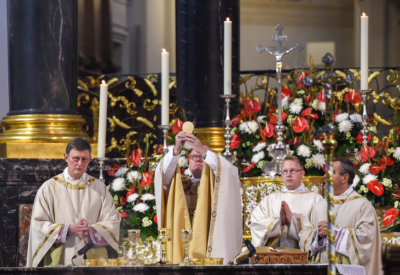 In our previous article we addressed how “transubstantiation” was an apt description of “how” the bread and wine become the Precious Body and Blood of Jesus – and noted along with the 13th Session of the Council of Trent, that the real “ancient and true” teaching was that of the Real Presence. So… what do we mean by the Real Presence?
In our previous article we addressed how “transubstantiation” was an apt description of “how” the bread and wine become the Precious Body and Blood of Jesus – and noted along with the 13th Session of the Council of Trent, that the real “ancient and true” teaching was that of the Real Presence. So… what do we mean by the Real Presence?
As the Gospel of Matthew tells us: While they were eating, Jesus took bread, said the blessing, broke it, and giving it to his disciples said, “Take and eat; this is my body.” Then he took a cup, gave thanks, and gave it to them, saying, “Drink from it, all of you, for this is my blood of the covenant, which will be shed on behalf of many for the forgiveness of sins. (Mt 26:26-28) (with similar language in Mk 14:22-24, Lk 22:17-20, and 1 Cor 11:23-25)
It is based on the ancient understanding of those Scriptures and the Sacred Tradition which handed on that understanding, that the Catholic Church professes that in the celebration of the Eucharist, bread and wine become the Body and Blood of Jesus Christ through the power of the Holy Spirit and the instrumentality of the priest. And still, we want to know how. St. Ambrose says about this becoming:
Be convinced that this is not what nature has formed, but what the blessing has consecrated. The power of the blessing prevails over that of nature, because by the blessing nature itself is changed. . . . Could not Christ’s word, which can make from nothing what did not exist, change existing things into what they were not before? It is no less a feat to give things their original nature than to change their nature.
That understanding is further enhanced by the Gospel of John, Chapter 6, the Bread of Life Discourse, in which Jesus said: “I am the living bread that came down from heaven; whoever eats this bread will live forever; and the bread that I will give is my flesh for the life of the world. . . . For my flesh is true food, and my blood is true drink” (Jn 6:51-55). From this the Church has always understood that the whole Christ is truly present, body, blood, soul, and divinity, under the appearances of bread and wine. This is what the Church means when she speaks of the “Real Presence” of Christ in the Eucharist.
Paragraph 1374 of the Catechism of the Catholic Church beautifully explains: “…In the most blessed sacrament of the Eucharist “the body and blood, together with the soul and divinity, of our Lord Jesus Christ and, therefore, the whole Christ is truly, really, and substantially contained.” “This presence is called ‘real’ – by which is not intended to exclude the other types of presence as if they could not be ‘real’ too, but because it is presence in the fullest sense: that is to say, it is a substantial presence by which Christ, God and man, makes himself wholly and entirely present.”
St. John Chrysostom understood what the Church means when it declares “Christ…makes himself wholly and entirely present.” Chrysostom wrote:
It is not man that causes the things offered to become the Body and Blood of Christ, but he who was crucified for us, Christ himself. The priest, in the role of Christ, pronounces these words, but their power and grace are God’s. This is my body, he says. This word transforms the things offered.
Not long after I was ordained a friend asked me “how it felt to have the power to make the Eucharist?” I understood the question was really, “what it like the first time you celebrated the Mass.” But sometimes our language betrays some of our “soft” thinking about the Eucharist. I have no power to “summons” Jesus body and blood, soul and divinity to our celebration of the Eucharist. I do have the promise of Christ, his instructions on what we are do, and the Sacred Tradition of how o understand it all – and then I can pray, “By the power of the Holy Spirit….” Maybe simply said: “Lord, you promised, I believe and because of that belief I trust that you will fulfill your promises to be really present – wholly and entirely present – body and blood, together with the soul and divinity.